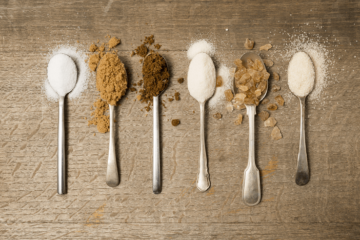What you should know about short- and long-chain carbohydrates!

What are carbohydrates?
Carbohydrates together with fats and proteins form the main macronutrient groups. These are the three basic building blocks of our diet and thus have great importance in health and weight loss. While fats and proteins serve partly or mainly as a building material in the organism, carbohydrates are above all an energy source. The correct energy balance – that is, the ratio of energy (food) consumed and the basic needs of our body and our activity levels – is the most reliable ways to make healthy weight loss possible. That’s why carbohydrates play a big role in weight loss. Our BMI Calculator can help you with calculating your optimal weight.
Again and again we receive questions about short-chain and long-chain carbohydrates. Therefore, we’d like to provide you with answers to the most frequently asked questions in the simplest possible terms. We deliberately refrain from describing biochemical processes related to carbohydrate-processing energy production, and instead focus on the carbohydrate properties that are most important for weight loss.
Short-chain and long-chain carbohydrates
The macronutrient carbohydrate is an energy source for our body and is summarized as follows:
- Monosaccharides (also called “simple sugars”) and disaccharides (also called “double sugars”) are short-chain carbohydrates. These are present in sweets and fruit, for example.
- Oligosaccharides (also called “multiple sugars”) are called long-chain carbohydrates. These are found, for example, in potatoes and legumes.
All carbohydrates are used by your body in the form of glucose or glycogen. First, your body splits the carbohydrate chains and, if necessary, rebuilds the individual chain links into glucose. This task is shared by the intestine and the liver. The end product, glucose, a monosaccharide (or “simple sugar”), is then released into the blood, where it is available as an energy source or energy reserve.
Your body can process short-chain carbohydrates faster than long-chain carbohydrates, because there are fewer links to separate. Short-chain carbohydrates, which are processed quickly, usually cause the blood sugar level to rise faster. The slower processing of the long-chain carbohydrates means your blood sugar level rises more slowly and you are satisfied longer. Blood sugar levels tell you how much sugar is in your blood – so the more carbs you consume and the faster they get into the bloodstream, the higher your blood sugar levels will go.
Carbohydrates and blood sugar levels
How fast carbohydrates get into your blood depends not only on the chain length, but also on the content of other nutrients that come with the carbohydrates into your body that also want to be processed. In addition, the degree of processing of the original product plays a role. White bread and other white flour products, such as pasta, are made from grains that originally were rich in nutrients, however, after being processed, the end product contain little to no nutrients. So your digestion does not have to split the carbohydrates anymore and they can get into your blood directly. As a result, your blood sugar level rises rapidly. Many fruits, on the other hand, contain short-chain carbohydrates and still have little effect on blood sugar levels because they also contain vitamins, minerals, and fiber that provide digestive capacity.
In addition to the type of sugar and the degree of processing of a food, the other macronutrients that a food contains – fats and proteins – are critical to your body’s blood sugar levels. Basically, it can be said that unprocessed, nutrient-rich foods affect the blood sugar only minimally.
Glycemic index and glycemic load
To find out what effect a carbohydrate-containing food will have on blood sugar, you can use the Glycemic Index (GI). This value tells you how fast the blood sugar level rises due to the carbohydrate content of a food. The lower the GI, the “slower” the carbohydrates contained. The Glycemic Load (GL) also takes into account the amount of carbohydrates in a food per hundred grams. For example, the GI of a normal carrot is quite high, but since it contains only three grams of carbs per hundred grams, the blood sugar does not increase significantly – unless you eat kilos of carrots.
What does weight loss have to do with blood sugar? Let’s make it simple: when your blood sugar level rises rapidly (e.g. through many short-chain carbohydrates, like in a piece of cake) it triggers a signal to which your body responds by telling your muscles and liver to store the sugar in your blood as glycogen. But when these stores are already full, your body quickly converts the sugar in the blood into triglycerides and stores them in the adipocytes – your fat cells. If weight loss is your goal, you can only eat carbohydrates which cause our blood sugar levels to rise quickly if you have previously emptied the storage in your muscles through physical activity – otherwise they end up as body fat.
Carbohydrates list
List of foods containing short-chain carbohydrates
- Candy
- Baked goods
- Most cereal varieties
- Dairy products
- Honey, agave syrup, maple syrup
- Malt/cane/grape/beet sugar
- Many fruits and some vegetables (in the form of fructose)
List of foods containing long-chain carbohydrates:
- Oatmeal, whole grains, wholemeal bread
- Potatoes, whole grain pasta, brown rice
- Nuts & various legumes (e.g. lentils)
- Some fruits
- Vegetables
Much of what you’ve heard about healthy foods before, also applies to short-chain and long-chain carbohydrates. Unsalted nuts are for example a better snack than sweets, whole grain bread is better than white bread, water is better than soft drinks, and so on.
Although fruit is included in both lists, you can actually safely eat fruit – in moderation. The German Nutrition Society (DGE) recommends, for example, two pieces of fruit a day – so two “handfuls”. that can be two apples, but also two portions of blueberries. With plenty of vitamins and a low glycemic index, fruit is a healthy snack, especially for those of us with a sweet tooth.
Lose weight with a low carb diet
A low carb diet, which reduces the total amount of carbohydrates consumed daily and relies on protein and healthy fats, is a promising diet for weight loss.This approach has often been scientifically proven as a sustainable weight loss method, and more than one step ahead of the many diets that circulate in women’s magazines or Internet forums. One of the reasons why this diet works is because it does not cause large increases in blood sugar, which are responsible for your body quickly storing body fat. Another advantage of low carb diets is that the extra protein helps to maintain your muscle mass, which is often lost, along with body fat, in most conventional diets. This is important because your muscles are a strong energy consumer and calorie burner. The preservation of muscle loss thus makes an important contribution to maintaining your weight after the weight loss phase.



